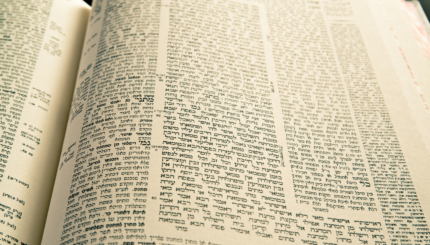Reprinted with permission from JOFA, the Jewish Orthodox Feminist Alliance.
One of the key goals of the women’s tefillah movement is to provide observant Jewish women with the liturgical knowledge, regular opportunities, and communal acceptance so that each woman can “pray as a Jew,” to borrow the title of Hayim Halevy Donin’s useful book. The premise is not that Orthodox women try to pray like Jewish men, but rather that they take responsibility for regular codified prayer and Torah study, together with other Jews.
 The image of women thus occupied should never have been controversial, of course. Rabbinic authorities have almost universally ruled that women should recite the Amidah. Maimonides posited that women’s prayer–the service of the heart–was necessary at least once a day, and Nahmanides ruled that women should pray both morning and afternoon because they, no less than men, yearn for divine mercy for themselves and their families. Rabbi Yechiel Michel Epstein (1829-1908) explained that Rashi and the Tosafot expected women to pray three times a day, albeit they were not responsible for time constraints.
The image of women thus occupied should never have been controversial, of course. Rabbinic authorities have almost universally ruled that women should recite the Amidah. Maimonides posited that women’s prayer–the service of the heart–was necessary at least once a day, and Nahmanides ruled that women should pray both morning and afternoon because they, no less than men, yearn for divine mercy for themselves and their families. Rabbi Yechiel Michel Epstein (1829-1908) explained that Rashi and the Tosafot expected women to pray three times a day, albeit they were not responsible for time constraints.
Indeed, many of us had grandmothers–pious, “beshaiteled” European women–who prayed daily and with great seriousness and dignity. But perhaps because the obligation for group prayer and the ability to “count” for a minyan (prayer quorum) was exclusive to Jewish males, the women’s tefillah movement had a revolutionary aura.
With your help, My Jewish Learning can provide endless opportunities for learning, connection and discovery.
Some women, feeling that the liturgy was “masculine” because of elements such as the recitation of shelo asani ishah (praise to God for not having created one a woman) and the masculine exclusivity of the Patriarchs invoked at the beginning of the Amidah, also felt that women praying publicly together meant trespassing on a male preserve.
Personal Prayer
My thoughts today focus on another aspect of praying as a Jew–the personalizing of prayer. For centuries, inserting personal prayers into and between codified liturgies was a desirable activity. As Donin notes, the Talmud mentions eleven sages and the supplications that each customarily added to the Shemoneh Esrei (Berakhot 16b-17a). The prayer of Mar, son of Rabina, a fourth-century rabbi, became a favorite and found its way into the prayer book at the end of the Amidah. Thus, the powerful ending of our current silent devotions began as one of many personal prayers.
Ironically, in recent decades Orthodox girls and women are far more likely to learn than Orthodox boys and men that it is appropriate to personalize even the highly codified daily prayers. Female learning environments more often instruct that when one comes to the 16th blessing of the Amidah, the shema kolaynu, (“hear our voices”) for example, “it is permissible, even desirable, to introduce extemporaneous requests…which may be said in any language.” Yet, many men report having gone through more than a decade of day schools and yeshivot without being encouraged to personalize their prayers.
Women in Prayer
Why has the personalizing of prayer become more common among women than men? The answers are sociological and historical. Jewish societies have encouraged women to personalize their prayers in many settings, the most ubiquitous being the lighting of the Shabbat candles. My mother taught me what her mother taught her: that each circling of our hands choreographs a beloved group of people to request blessings for–ourselves, our children, the community, the Jewish people.
The diverse tradition of tehines also supported quotidian, personal prayer. As the many books of women’s prayers now translated into English show, women’s prayers spanned the gamut of daily life. It is easy to see the drama of a tehine for going into labor, but one of my favorites is a prayer for baking bread: as she puts the loaves into the oven, the woman calls on the angels in heaven to come down and “make this bread rise.” What a testimonial to the dignity and importance of women’s work!
Because women were expected to pray throughout the day and the week as they went about their various tasks, the activity of personalizing prayer seemed natural, both to ordinary women and to the people who educated girls. For men, in contrast–especially as, in reaction to modernity, Orthodox life became increasingly rigid, text-based, and suspicious of innovation–many boys’ schools and yeshivot moved away from encouraging the personalization of prayer.
Typically in boys’ schools and yeshivot, spontaneity and creativity are feared, and even the personal dimension of judgment is suspect. Boys are more pressured to “toe the line” and conform to halakhic and liturgical norms, and thus personalization of prayer has been deeply meaningful to me in three ways.
Finding Meaning and Connection
First, prayers in the regular, codified liturgy have suddenly emerged vividly. For example, in the first painful weeks after my mother passed away, I found elohei neshamah shenatatah bi tehora hi in the preliminary birkhot hashahar service oddly consoling. “The soul that You gave me is pure; You created it; You fashioned it; You breathed it into me…One day You will take it away from me…As long as my soul is within me, I give thanks to You…”
Staying in the synagogue for my first complete Yizkor service, I read a sentiment from the book of Ecclesiastes with similar resonance: After death the body returns to the earth, where it originated, and the soul returns to God, where it originated. Despite my all-too-common doubts, that image of my mother’s soul rejoining something indefinable but infinite seemed profoundly right. On a happier note, one Friday evening on vacation in Vermont, each person in my family welcomed Shabbat at his or her own pace. As I stood alone on a balcony overlooking an exuberant mountain stream, the psalmist’s evocation of loudly melodic waters, mekolot mayyim rabbim, in Psalm 93 seemed overwhelmingly and joyously appropriate.
Second, moved by powerful personal events, I have experienced with gratitude a sense of divine presence, and, like innumerable women before me, have uttered unscripted prayers. Many of those moments, happy or sad, were related to my children. More than two decades ago, sitting in a new synagogue on Rosh Hashanah and reading about infertile biblical women, I “lost it” and was swept away in tears. I knew I was fortunate to have wonderful children, but I had recently endured three miscarriages in a row, and yearned for another child. I composed my own prayers that year. One year later, I sat in the same synagogue utterly nauseated, thrilled to be pregnant, but also, at age 38, more than a little fearful. Somehow I found myself once again “talking” to God. After praying, I felt calm: I felt that God was with me, and would give me the strength to deal with whatever came next.
Third, I am glad for every opportunity to insert my own special pleadings into the regular service–health for sick friends or relatives, happy events for the ones we love, a true and joyous peace for Israel. I am not really sure how I feel about hashgaha pratit, the divine ordering of and interference into daily life and human history, but I know that I need to say those prayers.
The personalizing of prayer is an historical Jewish conception. One can look at the moving sentiments that bracket the Amidah: “Please God, open my lips and my mouth will tell your praise,” we begin, and then we conclude by saying, “May the words of my mouth be acceptable to you.”
The conversation with God is pictured as a two-way, intimate dialogue that has to begin before it even begins, much like a powerful verse in the Song of Songs: “Draw me after you and we will run.”
The Rosh Hashanah before my daughter got married we sat together in the synagogue. In one sweet and unforgettable moment she turned to me and asked, “What do you think about when you say, ‘Hashem sefatai tiftakh ufi yagid tehilatekha?’” Then she said, “I think about all the things we women are doing to be able to draw closer to Hashem.”
That is one important meaning of Orthodox feminism and women’s tefillah, our legacy as women and as Jews. Observant women have much to offer Orthodox life as a whole by bringing personalized prayer into public focus as the birthright of both men and women. May it be God’s will that the meditations of our hearts bring strength and joy to our communities, our families, and to ourselves.
Rosh Hashanah
Pronounced: roshe hah-SHAH-nah, also roshe ha-shah-NAH, Origin: Hebrew, the Jewish new year.
Shabbat
Pronounced: shuh-BAHT or shah-BAHT, Origin: Hebrew, the Sabbath, from sundown Friday to sundown Saturday.
tefillah
Pronounced: tuh-FEEL-uh or tuh-fee-LAH, Origin: Hebrew, prayer.
Torah
Pronunced: TORE-uh, Origin: Hebrew, the Five Books of Moses.


